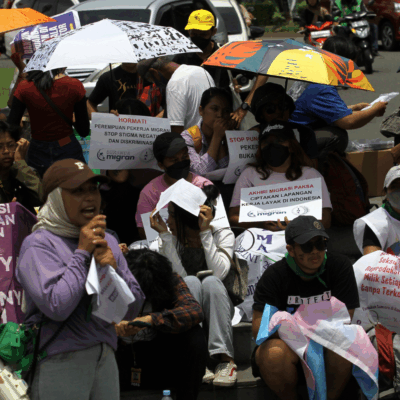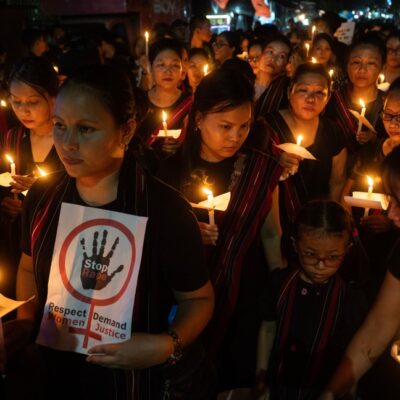“Woman Power: Moms of the Mars Mission” was a joyous headline in 2014 when India successfully launched a space probe orbiting Mars. Images of women scientists celebrating the success flashed across the globe. Education had propelled Indian women into space.
Meanwhile, on a humid day in August 2024, the body of a 31-year-old postgraduate doctor was found in a seminar hall at Kolkata’s R.G. Kar Medical College—raped and strangled after a 36-hour shift. The brutality jolted India’s conscience and rekindled memories of the 2012 “Nirbhaya” gang-rape in Delhi, when for the first time, the entire nation was forced to examine its epidemic of gender-based violence.
A decade apart, these incidents book-end a grim question: as Indian women break into classrooms, laboratories and boardrooms in unprecedented numbers, are they becoming bigger targets for gender based and sexual violence? What has come of the promise of education as a tool of emancipation and empowerment for women?
The paradox in the numbers
In the decade since 2012, India has seen two distinct trajectories move almost in tandem.
First, women’s educational and professional presence and their share in higher education rose steadily. The Ministry of Education’s All India Survey on Higher Education shows female enrolment climbing from 14.5 million in 2015–16 to 20.9 million in 2021–22, with women’s share of total enrolment up to 49% in 2021–22.
In STEM and professional courses, successive AISHE surveys show gender parity, while NASSCOM’s DEI insights found women form a third of large IT workforces.
Second, many indicators show high levels of violence against women. The National Crime Records Bureau (NCRB) datasets tracking a range of crimes against women show numbers continue to rise year on year. While many argue higher crime rates reflect better reporting, this hasn’t converted into improved conviction rates that wallowed around 27.1% in 2022. The fifth National Family Health Survey of Indian households show 29% of women between 18 and 49 have experienced physical violence and only 14% of these women report seeking support. The same survey found 17.3% of women who completed 12 or more years of schooling and 35% of women in employment had experienced physical violence. The simultaneous rise in educational and paid workforce participation and reported violence is a pattern that cannot be dismissed as coincidence.
Why success can provoke backlash
There is no single explanation for the paradox of employment and educational success and the escalating rates of violence. Rather, several interlocking dynamics help explain the situation.
First, patriarchal attitudes at play in pubic and professional spaces, such as the expectation that women will adhere to social “curfews” placed on their mobility. In the cases of Nirbhaya and the doctor in Kolkata, behavioural expectations of women are thought to have played a pivotal role – one of the perpetrators of the Nirbhaya horror stated that he and the other convicted rapists were angered at seeing a young woman with a male at “that” time of the night.
Second, the increasing rates of female participation in workforces and their increased purchasing power and agency to make choices is seen as a direct challenge to men’s authority and decision making. This is not a uniquely Indian experience but a wider issue across the world and highlights that when there is perceived decrease in power, there is a corresponding increase in violence.
Thid, early socialisation and “purity culture”. Adolescent gender-attitudes studies in India show persistent norms restricting girls’ mobility and a strong desire to maintain sexual “purity”. Girls’ participation in education is viewed as a risk to the maintenance of purity and enables their subsequent self-agency.
Fourth, political tokenism with announcements of CCTV, pink patrols, and helplines often outpacing investments in more systemic responses such as gender equality education and training, improving police capacity to investigate gender-based violence, more shelter homes, and witness protection programs. The India Justice Report 2022 documents systemic capacity gaps, including forensics and vacancies across police and judiciary. National government schemes such as ‘Beti Bachao, Beti Padhao’ (Save the Daughter, Educate the Daughter) have raised awareness but, a decade on, evaluations note under performance and misdirected funds.
What would real change look like?
In the aftermath of headline making attacks on women, much of the focus has been on the need for safety measures such as mandatory safe-room standards in workplaces and panic buttons in teaching hospitals and hostels; functioning CCTV; and secure, subsidized transport for night-shift workers. These align with recommendations from the Supreme Court Observer in the Kolkata case. Indeed, after the Nirbhaya case, amendments were made to criminal law on sexual assault. Efforts to fast-track legal process and bring in new laws to protect women in the workplace were implemented. While laudable, they fail to address the underlying factors that fuel violence.
Long-term change must address attitudes and socialisation. Key priorities should begin with a focus on a gender-smart curriculum that works by shifting gendered attitudes, providing age-appropriate consent education and teaching children about bystander action from middle through high school to reshape norms before they calcify.
Narratives need to be reframed to challenge beliefs that women’s empowerment emasculates men and encourage men to see the benefits of improved economic access from female workforce participation.
Normalising the role of fathers as caring parents and sharing care burden is another key intervention. The role of fathers in modelling and amplifying gender equality through parenting cannot be underestimated.
These measures are complementary: cultural shifts reduce the pool of potential perpetrators, while institutional investments increase the likelihood that crimes are prevented, detected and punished.
A realistic, accountable call to action
Education and employment should expand freedom, not increase risk. Positive outcomes require coordinated action from multiple actors. As India aspires to become a high middle income nation by 2047, all levers need to be applied to bring this aspiration to fruition; central and state governments need to invest in forensics and safe transport; universities and hospitals to audit security and implement access controls; employers to embed gender equality policies and reporting mechanisms; and civil society to sustain prevention campaigns and survivor support.
There is a need improve investigation quality, expand forensic capacity, and fast-track prosecution of serious crimes against women; raise conviction rates to create credible deterrence while protecting due process. Crucially, men must be part of the solution— societal pride in India’s women scientists and professionals must be matched by urgent, concrete steps to ensure no woman requires a bodyguard to pursue her ambitions. Without that, progress on paper will remain incomplete — and perilous in practice.
Anu Krishnan is founder and CEO Kulturbrille. She is an advocate for ending violence against women and works as a speaker, trainer, and facilitator. She is also the 2019 Victorian Multicultural Commission Award winner for her work in the prevention of family violence.
This article is part of a special mini-series published by Asialink’s Insights and the Asia Institute’s Melbourne Asia Review.




